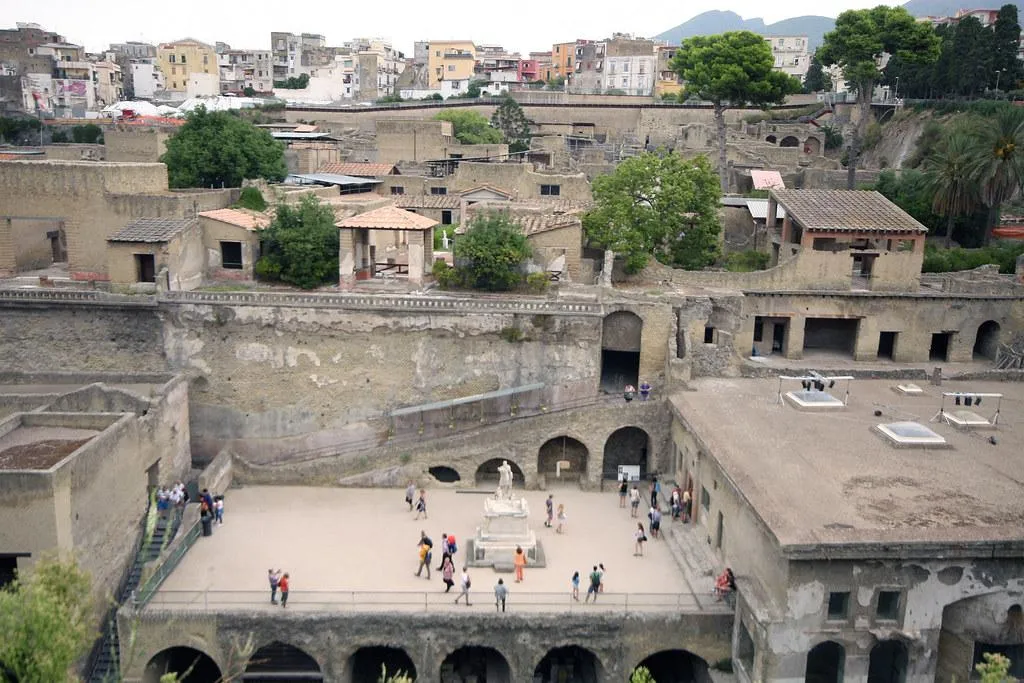New Analysis Reveals Vesuvius Victims’ Diverse Diets
Isotope ratios show that men and women in the ancient Roman city of Herculaneum had different dietary habits
:focal(700x546:701x547)/https://tf-cmsv2-smithsonianmag-media.s3.amazonaws.com/filer/e8/4a/e84a68df-ba6c-43d4-93f5-5696014ae41f/herculaneum_skeletons.jpg)
In the ancient Roman city of Herculaneum, men tended to consume more cereals and seafood, while women ate more eggs, dairy and meat, a new study published in the journal Science Advances suggests.
As Michelle Starr reports for Science Alert, the findings stem from an analysis of 17 people killed by the eruption of Mount Vesuvius in 79 C.E. Like neighboring Pompeii, Herculaneum was a popular seaside destination prior to its destruction by the volcano.
“The remains of those who perished at Herculaneum … offer a unique opportunity to examine the lifestyles across an ancient community who lived and died together,” says co-author Oliver Craig, an archaeologist at the University of York, in a statement. “Historical sources often allude to differential access to foodstuffs across Roman society but rarely provide direct or quantitative information.”
For the paper, the researchers studied the remains of 11 men and 6 women killed by a sudden blast of hot ash and gas that almost perfectly preserved their bones, reports Andrew Curry for Science magazine. People’s bones and teeth absorb different ratios of nitrogen and carbon depending on what they eat, so the team was able to pinpoint victims’ dietary habits by analyzing isotopes linked to specific foods.
The survey found that men ate over 50 percent more seafood protein than women and gained slightly more protein from grains. Women consumed more terrestrial meats, more eggs and dairy products, and more local fruits and vegetables. Overall, the men had greater variety in their diets.

Haaretz’s Ruth Schuster writes that the reasons for these individuals’ sex-based differences in diet aren’t totally clear. Men and women may or may not have eaten together; if they did, it’s possible that cultural conventions governed what foods were appropriate for each gender.
The researchers note that men were often responsible for fishing and probably ate some of their own catch. Overall, men had more access to pricey food, which would have included fresh fish. Additionally, men who were enslaved could be freed at a younger age than women, which may have allowed them access to a greater range of food options. A high percentage of the people of Herculaneum either were or had previously been enslaved, according to the study.
The findings corroborated historical records showing that ancient Romans consumed large amounts of olive oil. Oil made up at least 12 percent of the calories consumed by the people studied.
“Oil wasn’t a condiment, it was a proper ingredient,” lead author Silvia Soncin, an archaeologist at the University of York, tells Science. “They got a lot of energy out of it.”
As the scholars point out, the sample used may not represent the typical diets of ancient Romans. Herculaneum’s fertile volcanic soil and its location near a major port may have given residents access to a particularly diverse diet.
Last year, archaeologists unearthed a well-preserved snack bar in Herculaneum’s more famous neighbor, Pompeii. As Agence France-Presse (AFP) reported at the time, foods served there included duck, snails and some type of alcoholic drink.
/https://tf-cmsv2-smithsonianmag-media.s3.amazonaws.com/accounts/headshot/Livia_lg_thumbnail.png)
/https://tf-cmsv2-smithsonianmag-media.s3.amazonaws.com/accounts/headshot/Livia_lg_thumbnail.png)